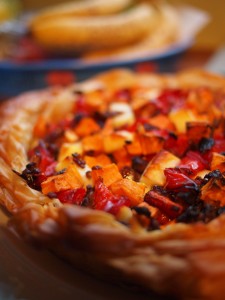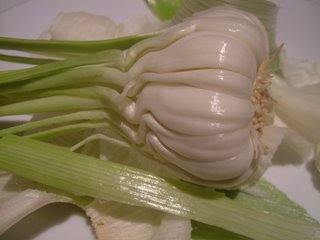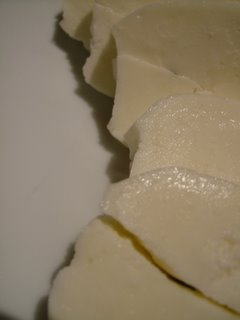
I’ve been busy working on some new recipes while having a month off from blogging. This is a really good-looking tart, great for parties. I love working with filo pastry; it’s very forgiving (any little tears can easily be ignored as you layer new sheets on), and the crisp finish is second to none, fantastic against the softened vegetables and the bite of the halloumi.
For one 20cm tart, you’ll need:
50g pancetta
1 large white onion
1 large sweet potato
4 pointed peppers
1 teaspoon fresh thyme leaves
100g halloumi
10 sheets filo pastry
25g melted butter
2 tablespoons extra-virgin olive oil
Salt and pepper
Preheat the oven to 200ºC (390ºF). Toss the pancetta, the onion, diced finely, and the peeled, cubed potato in the olive oil with a large pinch of salt and some pepper. Roast for 45 minutes, stirring once halfway through the cooking time. The sweet potatoes should be turning golden-brown, and the onions should be sweet and golden. Turn the oven down to 190ºC (370ºF).
While the sweet potato mixture is roasting, cut the peppers in half and grill them, skin side up, until the skins turn black and start to blister. Seal the hot, blistered peppers in a plastic freezer bag. The steam they release will help to loosen the skins and make them easy to slip off with your fingers.
Line a loose-bottomed 20cm tart dish with filo pastry. Lay a sheet halfway across the dish and fold over any that dangles over the edge. Lay another sheet across the other half of the dish, brush them both with butter, and rotate the dish 45 degrees. Repeat the process until you have used up all ten sheets. Prick the base of the pastry a few times with a fork, and line with a circle of greaseproof paper. Fill the tart case with baking beans and bake blind for ten minutes. Remove the beans and paper.
Chop the halloumi into pieces the same size as the chunks of sweet potato, and chop the skinned peppers. Toss the halloumi, peppers and thyme with the sweet potato mixture. Spoon the filling into the tart case. Bake for another 30-40 minutes until golden. Leave to rest for 10 minutes before popping the tart out of the case and serving.




